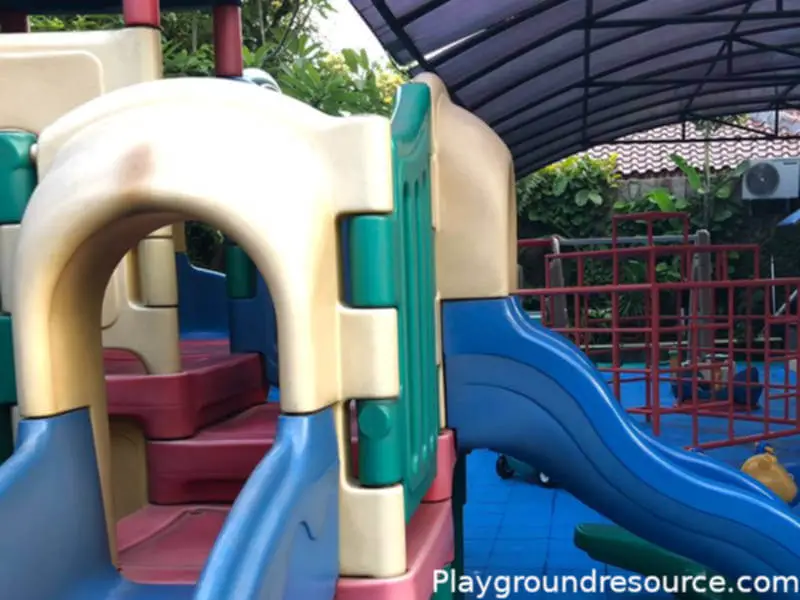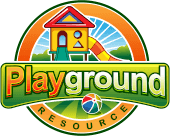
Painting old or weather-worn plastic playground equipment can be a great way to restore its “luster” and appearance. Plastic play equipment is durable and will last many, many years, but the outside appearance does not have the same lifespan.
Sunlight, rain, and snow causes the surface to fade and lose its original polish and color. Painting the plastic playground equipment will make the pieces look new again.
This is also a great way to save money. You can purchase or receive used plastic playground equipment and make it look new again!
In this article, I’ll explain in detail how to paint your plastic playground equipment, including what paint to use, if you need primer and sealer, and how to prep the toy or piece of equipment for painting. This is a fun, easy to DIY process with easy-to-follow steps.
Table of Contents
Clean and Prepare the Plastic Surface
Proper and careful preparation is the key to achieve a smooth and durable finish. First and foremost, wash the plastic surface completely using clean water and mild soap (liquid dawn dish soap works great) then rinse with fresh water.
Next, it is recommended to wipe the plastic down with rubbing alcohol before you paint. This step will ensure that all dirt, grease, molds, and mildews are totally removed. This step will help the paint better stick to the surface, ensuring a long-lasting paint job. And it really doesn’t take very long, just put on some plastic gloves and use a large rag.
The next step is sanding which is optional but advisable since it adds adhesion by creating a rough surface for the primer and paint to stick to and also helps you achieve a fine and smooth finish.
Sanding will also remove any imperfections. If you don’t want to sand the whole surface (which is understandable with large plastic equipment and toys) you can just sand the “shiny” (extra smooth) parts of the plastic. Paint and primer have an extra hard time sticking to these shiny spots.
Use fine-grit sandpaper. Fine grit means a grit of between 120 and 220.
Use of Primer
The purpose of using a primer is to help the paint to adhere to the plastic. This is especially important when painting plastic as the material is usually smooth and not porous like wood and other surfaces.
The porosity of a surface determines how well the surface will take primer and paint. A surface too porous means too much paint will be absorbed by the surface.
But plastic, with its very glossy surface, makes paint and primer adhesion difficult. The paint cannot lock into anything.
Paint primer is meant to provide a stable surface so subsequent layers can adhere to it. The primer also helps in hiding surface stains.
It allows the paint coat to provide nice bright colors rather than concealing blemishes or discoloration. Primer is available in both spray (recommended) and brush on. However, there may be no need to use a primer if you will be using a 2-in-1 paint/primer sprayer.
We will get into the different paints and primers specifically designed for plastic later.
Painting Process
Spray paint is considered the best option for plastic playground equipment and toys. It’s so much easier than dealing with buckets and brushes and clean-up. Spray paint is manufactured specifically to stick on glossy surfaces like plastic play equipment.
Plastic spray paint clings better to plastics than other varieties for a long-lasting coat and does not fade easily, making it perfect for outdoor equipment. Spray painting is also definitely faster than brushes and rollers. It ensures even coating that covers the whole surface it is sprayed on.
There are brands of spray paint specifically for plastic. This variety is advertised as uncomplicated and easy to use without the need for sanding and priming.
But, while painting with brushes may be slower, it is cheaper (per square foot) and covers more surface area than sprayers, and there are usually more color choices with the option to mix colors. You also usually only need 1 coat of primer and paint when brushing-on. Brush-on paint is best for larger areas.
Now let’s cover the best way to paint your plastic equipment using spray paint and brush-on paint.
Spray Painting
If using a separate primer, and not an all-in-one apply 2 coats of primer first then allow 1-2 hours of drying before applying the paint. After the paint dries, whether you used an individual primer or an all-in-one paint, it’s a good idea to use a sealer after the paint has completely dried. This will greatly extend the life of the paint.
1. Select the right type of paint. Again, plastic requires a special kind of paint that is designed to stick to a smooth surface. The wrong paint will not stick properly to the surface or produce bubbles, flakes or blisters.
2. After the plastic is clean and dry, shake the paint can prior to using. Hold the spray paint can 12 to 18 inches from the surface. Point the nozzle at the surface and press down. Sweep the paint can back and forth vertically or horizontally to apply a light and even coat.
3. Don’t aim the nozzle directly on one area as this will result in an unequal or irregular application.
4. Allow the coat to “dry to touch” before applying the second coat. This will take from eight minutes to half an hour (depending on outside humidity).
5. Apply the second coat. Most materials, including plastic, need at least two coats. Use the same motion as in the first coat.
If applying a sealer allow the paint/primer to dry. If you are in a humid environment, this could take around two hours. The paint must feel dry and solid.
The final step is allowing the paint and/or primer to cure after drying. It’s best to let the newly painted plastic equipment and/or toy cure overnight. Curing is when the paint molecules solidify and fully bond.
Product Recommendations:
All-in-one pray paint/primer on Amazon specifically designed for plastic – Krylon Fusion for Plastic, Krylon Fusion
Spray primer for plastic (use a separate primer for extra hold)- Dupi-Color Clear Adhesion Promoter Primer
Brush-on Painting
Using brush-on paint for plastic can be a good idea if you’re painting large areas. The best paint for outdoor and playground plastics is Acrylic-Latex Paint. Regular latex is not durable enough and other non-water based paints like solvent-based paints are much more toxic and more difficult to use. You use a water-based multi-surface primer with this (these products are usually labeled “Plastic Primer”). A sealer is optional, but will greatly extend the life and durability of your newly painted plastic.
Here’s what you’ll need:
- Synthetic bristle paint brushes
- Plastic Primer (Water-based multi-surface primer)
- Acrylic-Latex Paint
- Containers to hold the paint and primer (Disposable paint roller trays work great)
- Disposable gloves (optional)
1. Make sure you have selected the right type of paint and primer for plastic. In this case Acrylic Latex and “Plastic Primer”
2. After the Plastic has been cleaned and prepared, stir the primer and apply using the synthetic bristle paintbrush, making sure the plastic is well covered and coated.
3. Allow Primer to dry overnight or at least 4 hours, depending on humidity before applying paint. You should only need 1 coat of primer.
4. Stir the paint well and apply using a synthetic bristle paintbrush. Coat and cover the plastic with smooth, overlapping brush strokes. You should only have to apply 1 coat of the paint, but feel free to apply another coat after a few (or dry to touch) if you want.
Allow the paint to cure overnight before applying a sealer (I highly recommend using a sealer).
Product Recommendations:
Brush-on Primer for plastic- Kilz Adhesion High-Bonding and INSL-X Stix Acrylic Waterborne Bonding Primer
Brush-on Paint for plastic- Krylon ColorMaxx Brush-On Paint
Use of Sealer
Sealants for your newly painted plastic is not mandatory. Yet, applying this extends the paint’s durability. A sealer will give the freshly-painted plastic surface an additional level of protection.
The results become more stable and permanent especially if you are painting outdoor playground equipment. These sealants are available in a clear Gloss, Semi-Gloss, Satin, Flat and Matte finishes.
Wait until the paint cures overnight before applying a sealer. Spray on in the same manner you did with the paint coat. The sealant must be smooth, consistent and overlapping.
A single coat should be enough although you may apply more if the equipment is exposed to the elements year-round. Allow each layer to dry prior to applying another layer.
There you have it. Your newly-repainted plastic playground equipment looks new again and ready for use.
Your concern now would be maintenance, to make sure that the newly-painted plastic gear will last a very long time.
Recommended Products:
Spray plastic sealants Rust-Oleum American Accents Spray Paint and Krylon CoverMaxx Crystal Clear Acrylic
Maintenance Tips (How to Make Your Newly Painted Plastic Last)
To keep the equipment in its best condition, schedule regular cleanings on a weekend once a month or so and inspect for possible damages.
For dirt that can’t be sprayed off with a garden hose, you can use a soft scrub brush with a bucket of soapy water, then rinse clean using water from a bucket or garden hose.
Spring cleaning every year is recommended during the summer months. Inspect the equipment for mold, mildew and “scuff stains”. Also inspect nuts, screws, and bolts (if your equipment has any) looking for signs of rust- which can lead to hard to remove stains.
Consider storing your equipment in a garage/basement or using a yard tarp to cover your playground equipment and toys during the “off-season”. This will help greatly in preventing wear-and-tear due to the elements.
Final Thoughts and Considerations
Painting old and faded plastic playground equipment is a great way to save money. You don’t have to buy a new set or item. Save your money for more important needs.
Painting is the best option to restore dull surfaces that have been exposed to sunshine, dust, rain, and snow throughout the years. If you use a quality primer, paint, and sealer then this paint job should last for a very long time.
I hope this article has been helpful, remember to be safe and have fun!


